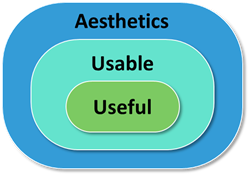This question comes up when discussing the accountabilities of the Scrum Team and the Developers. The Scrum Guide says on page 5:
The entire Scrum Team is accountable for creating a valuable, useful Increment every Sprint.
Developers are the people in the Scrum Team that are committed to creating any aspect of a usable Increment each Sprint.
Let us first look at possible definitions for USEFUL and USABLE:
- useful can be defined as "fit for purpose"
- usable can be defined as "fit to be used"
Now, let us explore how a user experiences a product:
- Usually, a user first experiences the surface of a product. Most users see a product and perceive its aesthetics in terms of visual appearance. Visual design is about proportions, color schemes and design elements. If this is done well, a user may be pleased with the appearance. However, as the saying goes "Don't judge a book by its cover", people often judge the inside from the outside.
- For a user to discover product functionality and use it, the product must be usable. If the user can't figure out how the product works, or the product is full of bugs, or the product suddenly ceases to function, the product is not usable. Therefore, an Increment must be usable to provide value. Being usable is driven through the Definition of Done.
- A user has a problem to solve. If a product helps a user to solve a problem in a better way such as in a faster way, or in a cheaper way, or in a more convenient way, or in a safer way, etc., then it is useful. In order to create a useful product, a Scrum Team has to discover users needs and translates these insights into product capabilities so that the user can achieve an outcome.
The following graphic shows the 3 different concerns in one picture: 
All three concerns are important for product success. However, it's easy to predict that products are not going to survive if they are not useful, no matter how beautiful (aesthetics) or easy to use (usable).
